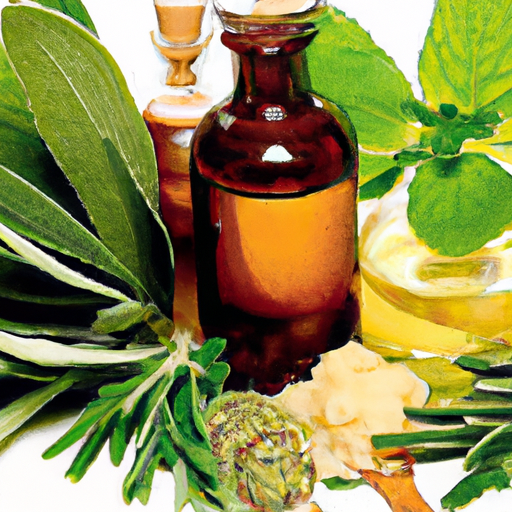Have you ever wondered if there are natural alternatives to antibiotics for treating bacterial infections? It’s a common concern, especially with the increasing resistance to antibiotics that we see today. Well, good news! In this article, we’re going to explore the world of natural antibiotics and how they can help combat bacterial infections. So, let’s dive in and find out more.
When it comes to bacterial infections, most people immediately think of going to the doctor and getting a prescription for antibiotics. But did you know that nature has provided us with several remedies that can be just as effective, if not more, in fighting off these infections? Yes, that’s right! There are numerous natural antibiotics that have been used for centuries to treat bacterial infections. From garlic and oregano to honey and ginger, these natural remedies have powerful antibacterial properties that can help you recover from an infection without the use of conventional antibiotics. In this article, we’ll explore the different natural antibiotics that you can incorporate into your wellness routine and learn about their potential benefits in combating bacterial infections. So, if you’re interested in exploring these natural alternatives, keep reading to find out more.
Understanding Bacterial Infections
Bacterial infections are caused by the invasion of harmful bacteria into the body. These infections can affect various parts of the body, such as the skin, respiratory system, urinary tract, and gastrointestinal tract. Understanding the different types of bacterial infections and their causes is crucial in finding effective treatment options.
Types of Bacterial Infections
There are several types of bacterial infections that commonly affect individuals. Some common examples include:
-
Urinary Tract Infections (UTIs): UTIs occur when bacteria enter the urethra and multiply in the urinary tract. Symptoms may include frequent urination, a burning sensation during urination, and cloudy or bloody urine.
-
Respiratory Infections: Bacterial respiratory infections, such as pneumonia and bronchitis, can be caused by bacteria like Streptococcus pneumoniae or Haemophilus influenzae. Symptoms may include fever, cough, and difficulty breathing.
-
Skin Infections: Bacterial skin infections, like cellulitis and impetigo, can occur when bacteria enter through breaks in the skin. Symptoms may include redness, swelling, and pus-filled blisters.
-
Gastrointestinal Infections: Bacterial gastrointestinal infections, such as food poisoning, are caused by consuming contaminated food or water. Symptoms may include diarrhea, nausea, vomiting, and stomach cramps.
Causes of Bacterial Infections
Bacterial infections are typically caused by the transmission of bacteria from person to person or from contaminated objects. Common causes include:
-
Direct Contact: Bacterial infections can be spread through direct contact with an infected person’s respiratory secretions, bodily fluids, or skin lesions.
-
Contaminated Food and Water: Consuming contaminated food or water that is infected with bacteria, such as Salmonella or E. coli, can lead to gastrointestinal infections.
-
Poor Hygiene: Improper handwashing, unsanitary living conditions, and lack of personal hygiene can increase the risk of bacterial infections.
-
Weakened Immune System: Individuals with weakened immune systems, such as those with HIV/AIDS or undergoing chemotherapy, are more susceptible to bacterial infections.
Symptoms of Bacterial Infections
The symptoms of bacterial infections can vary depending on the type of infection and the part of the body affected. Common symptoms may include:
-
Fever: A high body temperature is a common symptom of bacterial infections as the body tries to fight off the invading bacteria.
-
Pain or Discomfort: Bacterial infections can cause pain or discomfort at the site of infection, such as a sore throat or abdominal pain.
-
Inflammation: Redness, swelling, and heat at the site of infection are signs of the body’s immune response to the bacteria.
-
Discharge: Some bacterial infections, like urinary tract infections, can present with abnormal discharge, such as pus or blood.
The Threat of Antibiotic Resistance
Antibiotic resistance has become a concerning global issue. It occurs when bacteria develop the ability to survive and multiply in the presence of antibiotics, rendering these medications ineffective. Understanding the causes and consequences of antibiotic resistance is crucial in the fight against bacterial infections.
What is Antibiotic Resistance?
Antibiotic resistance refers to the ability of bacteria to resist the effects of antibiotics. This occurs when bacteria mutate or acquire resistance genes, making them less susceptible to the drugs designed to kill them. Over time, these resistant bacteria can multiply and spread, making infections more difficult to treat.
Causes of Antibiotic Resistance
The development of antibiotic resistance is primarily driven by the misuse and overuse of antibiotics. Some key factors contributing to the rise of antibiotic resistance include:
-
Overprescription: Antibiotics are often prescribed unnecessarily for viral infections, which are not affected by antibiotics. This leads to antibiotic exposure without any benefit, increasing the risk of resistance.
-
Incomplete Courses: Failing to complete a full course of antibiotics can promote antibiotic resistance. When bacteria are not fully eradicated, they have the opportunity to develop resistance.
-
Misuse in Agriculture: Antibiotics are routinely used in the agricultural industry to promote growth and prevent disease in livestock. This widespread use contributes to the selection and spread of antibiotic-resistant bacteria.
Consequences of Antibiotic Resistance
The consequences of antibiotic resistance are far-reaching and pose a significant threat to public health. Some potential consequences include:
-
Increased Mortality: Antibiotic-resistant infections are associated with higher mortality rates as these infections become more difficult to treat.
-
Prolonged Illness: Without effective antibiotics, bacterial infections can linger and become chronic, leading to prolonged illness and reduced quality of life.
-
Increased Healthcare Costs: The treatment of antibiotic-resistant infections requires more expensive and often less effective alternative medications, resulting in increased healthcare costs.
-
Loss of Treatment Options: As antibiotic resistance continues to rise, we risk losing essential antibiotics, resulting in limited treatment options for bacterial infections.
Introduction to Natural Antibiotics
As the threat of antibiotic resistance grows, there is a growing interest in natural antibiotics as alternatives to conventional medications. Natural antibiotics, derived from plants or other natural sources, have been used for centuries to combat bacterial infections. Understanding what natural antibiotics are, their advantages, and limitations is essential in exploring their potential use.
What are Natural Antibiotics?
Natural antibiotics are substances derived from nature that possess antibacterial properties. These substances can inhibit the growth or kill bacteria, similar to conventional antibiotics. Unlike synthetic antibiotics, natural antibiotics are typically derived from plants, such as herbs and spices, and are considered a more holistic approach to treating bacterial infections.
Advantages of Natural Antibiotics
One of the notable advantages of natural antibiotics is their potential to combat antibiotic-resistant bacteria. Natural antibiotics often contain a complex mixture of bioactive compounds that may have synergistic effects, making it more difficult for bacteria to develop resistance. Additionally, natural antibiotics may have fewer side effects compared to conventional antibiotics.
Limitations of Natural Antibiotics
While natural antibiotics have their advantages, it is important to acknowledge their limitations. Some key limitations include:
-
Limited Spectrum: Natural antibiotics may have a narrower spectrum of activity, meaning they may only be effective against certain types of bacteria. This limits their use in treating a wide range of bacterial infections.
-
Lack of Scientific Evidence: While natural antibiotics have been used for centuries, the scientific evidence supporting their effectiveness is often limited. Rigorous scientific studies are still needed to validate their efficacy and safety.
-
Standardization and Quality Control: Unlike conventional antibiotics, natural antibiotics can vary in terms of their purity, potency, and quality. Ensuring standardized manufacturing practices and quality control can be challenging.
Effective Natural Antibiotics for Bacterial Infections
While there are numerous natural antibiotics available, some have been extensively studied and shown promise in treating bacterial infections. Here are five examples of effective natural antibiotics:
Garlic
Garlic possesses potent antibacterial properties, thanks to a compound called allicin. Allicin has been shown to inhibit the growth of various bacteria, including antibiotic-resistant strains. Consuming raw or cooked garlic regularly can help support your body’s natural defense against bacterial infections.
Honey
Honey has been used for centuries as a traditional remedy for wounds and infections due to its antimicrobial properties. Honey contains hydrogen peroxide, which can kill bacteria. It also has a low water content, acidic pH, and natural enzymes that create an unfavorable environment for bacterial growth.
Turmeric
Turmeric, a golden spice commonly used in cooking, contains a compound called curcumin. Curcumin has been found to have potent antibacterial effects against a wide range of bacteria. Incorporating turmeric into your diet or using it topically can help combat bacterial infections.
Ginger
Gingerol, a bioactive compound found in ginger, is known for its antibacterial properties. Ginger has been used traditionally to alleviate various infections, including respiratory and gastrointestinal infections. Consuming ginger tea or adding fresh ginger to your meals can provide natural antibacterial support.
Echinacea
Echinacea is a popular herb known for its immune-boosting properties. It also has antibacterial effects, particularly against respiratory tract infections like the common cold. Echinacea supplements or herbal teas can be beneficial in supporting your immune system and combating bacterial infections.
Garlic: A Potent Natural Antibiotic
Garlic is not only a delicious addition to your meals but also a potent natural antibiotic. Its antibacterial properties are attributed to a compound called allicin, which has been found to effectively inhibit the growth of bacteria. Here’s why garlic is a valuable natural antibiotic against bacterial infections:
Benefits of Garlic in Fighting Bacterial Infections
Garlic has been used for centuries in traditional medicine to treat various infections. Its antibacterial properties make it effective against both gram-positive and gram-negative bacteria, including antibiotic-resistant strains. Garlic can also stimulate the immune system, helping your body fight off bacterial infections more effectively.
How to Use Garlic as an Antibiotic
To maximize the antibacterial benefits of garlic, it is recommended to consume it raw or lightly cooked. Crushing or chopping fresh garlic cloves releases allicin, the active compound responsible for its antibacterial effects. You can add crushed garlic to your meals, mix it with honey for added benefits, or take garlic supplements.
Precautions and Side Effects
While garlic is generally safe for consumption, some individuals may experience mild side effects, such as bad breath, heartburn, or stomach upset. Garlic may also interact with certain medications, including blood thinners, so it is advisable to consult with a healthcare professional if you have any underlying medical conditions or are taking medications.
Honey: Nature’s Healing Sweetener
Honey, nature’s sweetener, is not only delicious but also possesses remarkable antibacterial properties. Its ability to inhibit the growth of bacteria and promote wound healing has been recognized for centuries. Here’s why honey is a valuable natural antibiotic for bacterial infections:
Antibacterial Properties of Honey
Honey contains several substances that contribute to its antibacterial properties. These include low water content, high sugar concentration, an acidic pH, and natural enzymes that produce hydrogen peroxide, a potent antibacterial agent. These factors create an unfavorable environment for bacterial growth, helping to combat infections.
Application of Honey for Bacterial Infections
Honey can be applied topically to wounds or infected areas to effectively fight bacterial infections. Simply apply a thin layer of honey to the affected area and cover it with a clean bandage. It is important to use raw, unprocessed honey to ensure its antibacterial properties are preserved.
Choosing the Right Honey for Antibiotic Use
Not all honey is created equal when it comes to its antibacterial properties. Manuka honey, derived from the nectar of the Manuka tree in New Zealand, is highly regarded for its potent antibacterial activity. Look for Manuka honey with a Unique Manuka Factor (UMF) rating to ensure its quality and antibacterial efficacy.
Turmeric: A Golden Spice against Bacteria
Turmeric, with its vibrant golden color and distinctive flavor, is more than just a culinary spice. It contains a bioactive compound called curcumin, which exhibits significant antibacterial effects. Here’s why turmeric is a valuable natural antibiotic against bacterial infections:
Curcumin’s Antibacterial Effects
Curcumin has been shown to have broad-spectrum antibacterial activity against various bacteria, including antibiotic-resistant strains. It works by disrupting the bacteria’s cell membranes, inhibiting their growth, and promoting cell death. Curcumin can also enhance the effectiveness of conventional antibiotics, making it a valuable addition to treatment strategies.
Ways to Incorporate Turmeric as an Antibiotic
Turmeric can be easily incorporated into your diet to enjoy its antibacterial benefits. You can add turmeric powder to your meals, use it to season meats or vegetables, or make a warm turmeric latte. For concentrated doses, curcumin supplements are available, but it is important to choose high-quality products from reputable brands.
Potential Interactions and Precautions
While turmeric is generally safe for consumption, it may interact with certain medications, such as blood thinners and medications for diabetes. If you are taking any medications or have underlying health conditions, it is best to consult with a healthcare professional before using high doses of turmeric or curcumin supplements.
Ginger: A Versatile Bacterial Fighter
Ginger, known for its zesty flavor and aromatic properties, is not only a culinary delight but also a versatile natural antibiotic. It contains a bioactive compound called gingerol, which possesses antibacterial effects. Here’s why ginger is a valuable natural antibiotic against bacterial infections:
Gingerol’s Antibiotic Properties
Gingerol has been found to exhibit antibacterial activity against various bacteria, including those responsible for respiratory and gastrointestinal infections. Gingerol works by disrupting the bacteria’s cell membranes, inhibiting their growth, and promoting their destruction. Its antibacterial effects make ginger a valuable addition to your natural antibiotic toolkit.
Usage of Ginger for Bacterial Infections
Incorporating ginger into your daily routine can provide a natural boost to your body’s defenses against bacterial infections. You can brew ginger tea by steeping slices of fresh ginger in hot water. Adding fresh ginger to your meals, smoothies, or juices is another way to enjoy its antibacterial benefits.
Safety Considerations
Ginger is generally safe for consumption, but it may cause mild side effects in some individuals, such as heartburn or stomach upset. High doses of ginger may also interact with certain medications, such as blood thinners. If you have any underlying medical conditions or are taking medications, it is advisable to consult with a healthcare professional before using high doses of ginger.
Echinacea: Boosting Your Immune System
Echinacea is a popular herb known for its immune-boosting properties. It can also exert antibacterial effects, making it a valuable natural antibiotic against bacterial infections. Here’s why echinacea is a valuable addition to your natural antibiotic arsenal:
Antibacterial Effects of Echinacea
Echinacea contains compounds called phenols, which have been found to possess antibacterial activity against various bacteria. It can help stimulate the immune system, enhancing your body’s ability to fight off bacterial infections naturally. Echinacea is particularly effective against respiratory tract infections, such as the common cold.
Methods of Using Echinacea as a Natural Antibiotic
Echinacea is available in various forms, including teas, tinctures, capsules, and extracts. Drinking echinacea tea or taking echinacea supplements can provide immune support and help combat bacterial infections. It is essential to follow the recommended dosages and consult with a healthcare professional, especially if you have any underlying medical conditions.
Potential Adverse Reactions
While echinacea is generally well-tolerated, some individuals may experience mild side effects, such as upset stomach, dizziness, or skin rashes. Individuals with autoimmune conditions or allergies to plants in the Asteraceae family (such as ragweed) should exercise caution when using echinacea and consult with a healthcare professional.
Conclusion
In the face of rising antibiotic resistance, exploring alternative treatments for bacterial infections is crucial. Natural antibiotics, such as garlic, honey, turmeric, ginger, and echinacea, offer a promising approach. These natural remedies not only possess antibacterial properties but also provide additional health benefits. However, it is important to acknowledge the limitations of natural antibiotics and the need for further scientific research. Balancing the use of natural antibiotics with conventional treatments under the guidance of healthcare professionals can be a comprehensive approach to combat bacterial infections effectively. By harnessing the power of nature, we can continue to fight bacterial infections and safeguard our health for generations to come.


